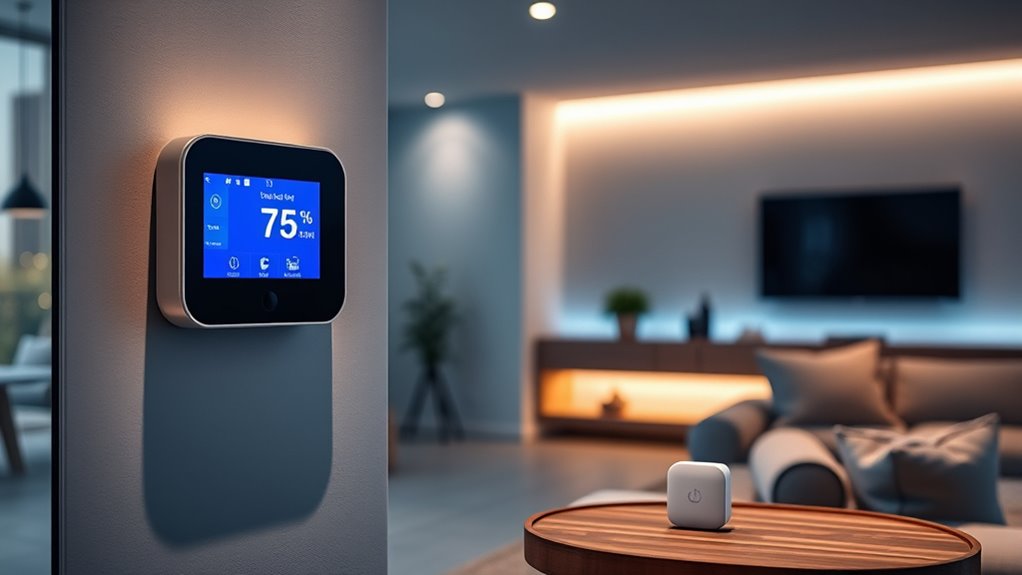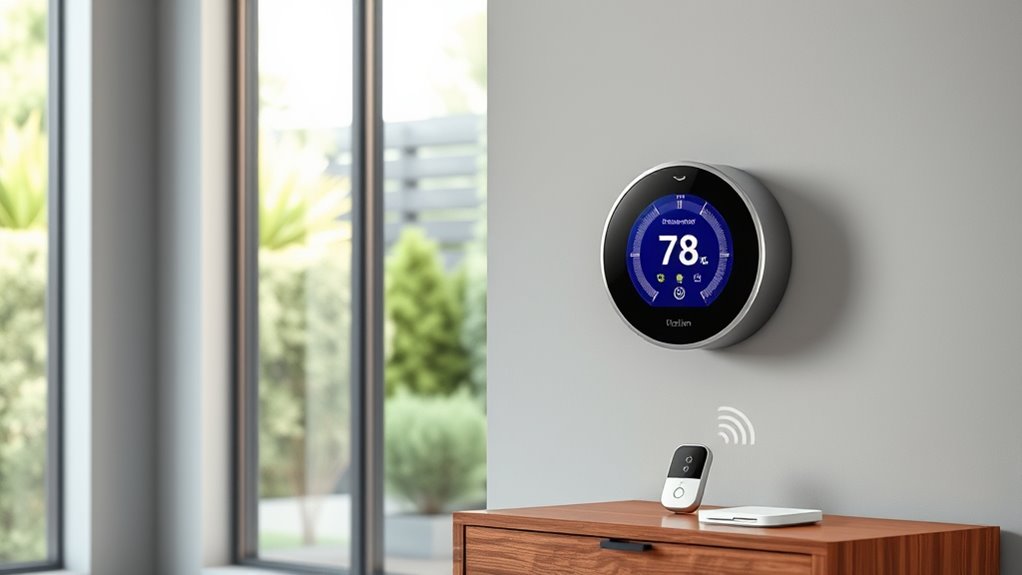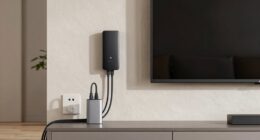If you’re looking for the best smart thermostats with remote sensors, I recommend options like ecobee Premium, T9, Nest Learning Thermostat, and Sensi Touch, which support multiple sensors for precise multi-room control. These devices improve comfort and save energy by adjusting based on where you are or room occupancy. With features like voice control, sleek displays, and easy setup, there’s a perfect fit for your home. Keep exploring to find the one that suits your needs best.
Key Takeaways
- Many top smart thermostats support remote sensors for accurate multi-room temperature control and energy efficiency.
- Compatibility varies; check if the thermostat and sensors support your HVAC system type and communication protocols.
- Proper sensor placement is crucial for optimal climate regulation; most sensors should be positioned away from drafts and heat sources.
- Features like programmable schedules, voice control, and energy-saving reports enhance user experience and home automation.
- Installation complexity varies; some models support DIY setup with all necessary components, while others may require professional assistance.
ecobee Smart Thermostat Premium with Sensors
If you’re looking to cut energy costs while maintaining consistent comfort throughout your home, the ecobee Smart Thermostat Premium with Sensors is an excellent choice. It can save you up to 26% annually on heating and cooling costs, thanks to its ENERGY STAR certification and smart sensor technology. The included sensors target key rooms, reducing hot or cold spots and optimizing energy use. Its sleek design features a vibrant display and advanced occupancy sensing. Plus, it’s compatible with most HVAC systems and supports voice control via Alexa, Siri, or Google Assistant. Overall, it combines efficiency, convenience, and style for smarter home climate management.
Best For: homeowners seeking energy savings, smart home integration, and enhanced home comfort with modern aesthetics.
Pros:
- Saves up to 26% annually on heating and cooling costs, reducing energy expenses
- Includes smart sensors that optimize comfort in key rooms and reduce hot or cold spots
- Supports voice control with popular assistants and features a sleek, user-friendly design
Cons:
- Requires Apple Home Hub for Siri integration, which may entail additional equipment costs
- Compatibility limited to most 24VAC HVAC systems, excluding some proprietary or high-tech setups
- Advanced features like energy-saving alerts and security notifications may require a subscription to ecobee Smart Security
T9 WiFi Smart Thermostat with Room Sensor
The T9 WiFi Smart Thermostat with Room Sensor is an excellent choice for homeowners seeking precise, multi-room comfort control and energy savings. It allows remote management via its mobile app and offers auto Home/Away Scheduling to optimize temperature settings based on your schedule. The smart sensors detect occupancy within a 200-foot range, automatically adjusting comfort levels in different rooms. It’s compatible with various heating systems, including forced air, hot water, and heat pumps, though not electric baseboard heat. You can control it through voice commands with Alexa, Google Assistant, or Apple HomeKit, making home climate management seamless and efficient.
Best For: homeowners seeking precise multi-room climate control, remote management, and energy savings through smart technology and voice integration.
Pros:
- Allows remote control and scheduling via mobile app for convenience.
- Uses smart sensors to detect occupancy and optimize comfort in multiple rooms.
- Compatible with various heating systems and popular voice assistants like Alexa, Google, and Apple HomeKit.
Cons:
- Not compatible with electric baseboard heat (120-240V).
- Requires a C-wire or low-voltage power adapter for installation.
- Limited to forced air, hot water, steam, and heat pump systems, excluding some electric heating types.
Sensi Touch 2 Smart Thermostat with Touchscreen
The Sensi Touch 2 Smart Thermostat with Touchscreen stands out for its intuitive color display and seamless smartphone integration, making it ideal for homeowners who want easy control and real-time temperature adjustments. Its user-friendly interface simplifies programming, while the ENERGY STAR certification guarantees energy efficiency. Installation is straightforward with a detailed app guide and universal Bluetooth technology, though a C-wire is required. Compatible with most HVAC systems and Sensi Room Sensors (sold separately), it helps balance temperatures throughout your home. Plus, its smart features monitor system performance, send maintenance alerts, and support voice control via Alexa, combining convenience with energy savings.
Best For: homeowners seeking an easy-to-install, energy-efficient smart thermostat with a user-friendly touchscreen interface and voice control capabilities.
Pros:
- Intuitive color touchscreen display for simple navigation and control
- Seamless smartphone and voice control integration with Alexa
- ENERGY STAR certified, promoting energy savings and lower utility bills
Cons:
- Requires a C-wire for installation, which may not be available in all homes
- Compatible HVAC systems and sensors sold separately, potentially increasing overall cost
- Installation and setup, while DIY-friendly, may still be challenging for some users unfamiliar with electrical work
Smart Thermostat with Room Sensor and Large Touchscreen
For homeowners seeking a user-friendly smart thermostat with a large touchscreen, this model offers an intuitive interface and precise temperature control. It supports over 95% of 24VAC HVAC systems, including central AC, heat pumps, boilers, and furnaces, with easy self-test setup. The large 3.95-inch screen displays clear readings, while the smart sliding touch design makes adjustments simple for everyone, even kids and seniors. It works seamlessly with Provirtec smart thermo-hygrometers for real-time monitoring and uses body location-based sensing to optimize comfort and energy savings. Plus, it maintains stable WiFi and Bluetooth connectivity, ensuring reliable control even during network disruptions.
Best For: homeowners seeking an easy-to-use, large-screen smart thermostat compatible with most 24VAC HVAC systems and featuring precise temperature control.
Pros:
- Supports over 95% of 24VAC HVAC systems including central AC, heat pumps, boilers, and furnaces.
- Large 3.95-inch touchscreen with intuitive sliding touch controls for effortless adjustments.
- Compatible with Provirtec thermo-hygrometers for real-time home environment monitoring.
Cons:
- Requires a 2.4 GHz WiFi network for full functionality and firmware updates.
- WiFi connection is necessary for pairing with certain accessories and upgrades, limiting use with other networks.
- No mention of voice control or integration with smart home ecosystems beyond WiFi and BT Mesh.
Google Nest Learning Thermostat (4th Gen, 2024) with Nest Temperature Sensor
If you want a smart thermostat that seamlessly adapts to different rooms, the Google Nest Learning Thermostat (4th Gen, 2024) with Nest Temperature Sensor is an excellent choice. It features a sleek Obsidian finish, a larger display, and Dynamic Farsight for easy visibility from across the room. It works with most 24V systems and doesn’t require a C wire in many homes. You can control it remotely via the Google Home app or with voice commands through Alexa, Siri, or Google Assistant. The included Nest Temperature Sensors help manage hot and cold spots, ensuring comfort while saving energy and lowering bills.
Best For: homeowners seeking a sleek, customizable smart thermostat that easily integrates with existing HVAC systems and offers remote control and energy savings.
Pros:
- Stylish Obsidian finish with larger display and Dynamic Farsight for excellent visibility.
- Compatible with most 24V systems and does not usually require a C wire, simplifying installation.
- Supports voice commands via Alexa, Siri, and Google Assistant, and integrates seamlessly with Google Home app.
Cons:
- May require additional compatibility checks for specific HVAC systems.
- Some users might find the setup process challenging without prior DIY experience.
- Premium features and sensors come at an additional cost.
Sensi Smart Thermostat
Anyone looking for an easy-to-install, budget-friendly smart thermostat that integrates seamlessly with most residential HVAC systems will find the Sensi Smart Thermostat a great choice. Its Wi-Fi connectivity, programmable controls, and DIY-friendly setup make it accessible for most homeowners. Compatible with boilers, furnaces, heat pumps, and air conditioners, it often doesn’t need a c-wire, simplifying installation. The sleek design features a 5-inch LED display and intuitive controls. It works with Alexa, Google Assistant, and other smart home platforms, offers energy savings of around 23%, and provides useful maintenance alerts. Overall, it’s a reliable, user-friendly option for smarter climate control.
Best For: homeowners seeking an affordable, easy-to-install smart thermostat that seamlessly integrates with most HVAC systems and offers remote control and energy savings.
Pros:
- Simple DIY installation with minimal wiring requirements
- Compatible with popular voice assistants like Alexa and Google Assistant
- Provides energy savings of approximately 23% and useful maintenance alerts
Cons:
- Slight delays (20-25 seconds) between adjusting temperature and system response
- Limited reporting accuracy during HVAC malfunctions or system issues
- Lacks compatibility with Bixby and some advanced usage data features
Amazon Smart Thermostat, Alexa & Ring Compatible
The Amazon Smart Thermostat stands out for its seamless compatibility with Alexa and Ring, making it an excellent choice for those already invested in these smart home ecosystems. Launched in 2021, it supports most 24V HVAC systems, including force air and heat pumps, but not 110-240V systems like electric baseboard heat. It offers easy setup via the Alexa app and features automatic adjustments based on presence, schedules, and Thermostat Hunches. Its sleek design includes on-device buttons and app control, with energy-saving tools like humidity sensing and air filter management. While reliable for most, some users report connectivity issues after outages, so careful installation is advised.
Best For: smart home enthusiasts seeking an affordable, Alexa-compatible thermostat with easy setup and automation features for compatible 24V HVAC systems.
Pros:
- Seamless integration with Alexa and Ring for voice control and automation
- User-friendly app with scheduling, energy insights, and filter management
- Sleek design with on-device buttons and straightforward installation process
Cons:
- Some users experience connectivity issues after power outages requiring re-pairing
- Not compatible with 110-240V systems like electric baseboard heat
- Occasional app crashes on older Android devices during scheduling or setup
ecobee Smart Thermostat Essential – Wi-Fi Programmable Thermostat
Looking to cut energy costs without sacrificing comfort? The ecobee Smart Thermostat Essential helps you do just that, saving up to 23% annually on heating and cooling. It automatically adjusts your home’s temperature when you’re away and enhances comfort when you’re home, all controllable remotely via the ecobee app. Easy to install with no C-Wire needed—just use the Power Extender Kit—it’s compatible with most HVAC systems, including gas, electric, and heat pumps. Its color touchscreen makes adjustments simple, and it works seamlessly with Apple HomeKit, Google Assistant, and Alexa for voice control and automation.
Best For: homeowners seeking an easy-to-install, energy-efficient smart thermostat compatible with a variety of HVAC systems and smart home ecosystems.
Pros:
- Saves up to 23% annually on heating and cooling costs.
- No C-Wire needed for installation, using the Power Extender Kit.
- Compatible with major smart home platforms like Apple HomeKit, Google Assistant, and Alexa.
Cons:
- May require verification for compatibility with specific HVAC systems.
- Trim kit and Power Extender Kit sold separately, adding to initial cost.
- Limited to Wi-Fi enabled systems, not suitable for non-smart or older HVAC units.
T9 WiFi Smart Thermostat with Room Sensor and Touchscreen
If you want a smart thermostat that offers precise temperature control and easy integration with your smart home, the T9 WiFi Smart Thermostat with Room Sensor and Touchscreen is an excellent choice. It works with most heat/cool oil furnace systems and supports forced air, hot water, steam, and heat pumps with electric backup. The touchscreen display supports voice commands via Alexa and Google Assist, making control seamless. You can add optional Smart Room Sensors to focus temperature management on multiple rooms. Plus, it helps save energy through adaptive scheduling, energy reports, and utility program links, earning rewards for efficiency. Setup is straightforward, with everything included in the box.
Best For: homeowners seeking a versatile, energy-efficient smart thermostat compatible with various heating systems and easy to control via voice commands and mobile app.
Pros:
- Supports multiple heating systems including forced air, hot water, steam, and heat pumps with electric backup
- Seamless voice control compatibility with Alexa and Google Assist
- Includes everything needed for quick and straightforward installation, including a power adapter
Cons:
- Not compatible with electric baseboard heat (120-240V)
- Requires a C-wire power adapter for heating-only oil furnace systems
- Smart Room Sensors are sold separately and must be purchased additionally
Google Nest Thermostat E Bundle
For homeowners seeking an easy-to-install smart thermostat that learns their habits and helps cut energy costs, the Google Nest Thermostat E Bundle is an excellent option. It features auto-scheduling, remote control via the Nest app, and compatibility with Alexa, Google Assistant, and various heating systems like boilers and heat pumps. The included Nest Temperature Sensor allows precise control across different rooms, enhancing comfort. Installation typically takes about 60 minutes, and the device is compatible with most systems. It automatically adjusts settings when you’re away, saving energy—average savings range from 10-15%. Overall, it’s a user-friendly, energy-efficient choice for smarter home climate management.
Best For: homeowners looking for an easy-to-install, energy-saving smart thermostat that learns their habits and offers remote control.
Pros:
- Simple installation process typically completed within 60 minutes
- Compatible with a wide range of heating systems including boilers and heat pumps
- Offers remote control via the Nest app and voice commands with Google Assistant and Alexa
Cons:
- Auto-scheduling may override manual settings, causing user frustration
- Limited fan scheduling options and temperature swing adjustments
- Some users experience wiring compatibility issues requiring professional installation
MoesGo Programmable WiFi Smart Thermostat with C-Wire Adapter
The MoesGo Programmable WiFi Smart Thermostat with C-Wire Adapter stands out as an excellent choice for homeowners with conventional or heat pump systems who want customizable schedules and remote control. It supports 2H/2C and 4H/2C setups, though it doesn’t work with heating-only systems or high-voltage wiring. Installation is straightforward if you have a C-wire or use the included adapter, especially for furnaces with an extra wire. The thermostat offers 7-day programming, remote sensors, and voice control via Alexa and Google Assistant. While some users find setup challenging and note interface bugs, overall, it provides good energy savings and remote convenience.
Best For: homeowners with conventional or heat pump HVAC systems seeking customizable scheduling, remote control, and voice compatibility.
Pros:
- Supports 7-day programming with multiple modes for flexible scheduling
- Compatible with Alexa and Google Assistant for hands-free voice control
- Includes free remote sensor for more accurate temperature monitoring
Cons:
- Setup can be challenging, especially with unclear instructions or WiFi network issues
- Some users report interface bugs, device malfunctions, or temperature fluctuations
- Build quality is mostly plastic and may feel cheap or rough to some users
MOES Smart Programmable Thermostat with Zone Sensor and C-Wire Adapter
The MOES Smart Programmable Thermostat with Zone Sensor and C-Wire Adapter is an excellent choice for homeowners seeking reliable, energy-efficient climate control across diverse heating systems. It supports systems like heat pumps, gas, electric, and oil, and integrates with Alexa, Google Assistant, and the Tuya app for remote access. With a 7-day programmable schedule, auto changeover, and energy savings over 23%, it offers flexibility and efficiency. The device features a sleek touchscreen, supports calibration, and includes a zone sensor within 9 feet. While setup can be tricky, especially wiring, once installed, it delivers dependable control and compatibility for various HVAC configurations.
Best For: homeowners seeking a versatile, energy-saving smart thermostat compatible with various HVAC systems and voice assistants.
Pros:
- Supports multiple systems including heat pumps, gas, electric, and oil, with flexible wiring options.
- Features a sleek touchscreen design with customizable 7-day programmable schedules and energy savings.
- Compatible with Alexa, Google Assistant, and Tuya/Smart Life app for remote control and easy integration.
Cons:
- Setup can be complicated, especially wiring and Wi-Fi connection modes, potentially requiring professional assistance.
- Some users report temperature inaccuracies and calibration challenges affecting performance.
- App stability issues and hardware durability concerns have been noted in user reviews.
ecobee Smart Thermostat Enhanced
If you’re looking to maximize energy savings while maintaining consistent comfort, the ecobee Smart Thermostat Enhanced is an excellent choice. It can save you up to 26% annually on heating and cooling costs by automatically adjusting the temperature when you’re away, preventing unnecessary energy use. It preheats or precools your home before you arrive, ensuring ideal comfort. The thermostat also considers humidity, keeping your indoor environment comfortable all day and night. With voice control compatibility for Siri, Alexa, and Google Assistant, plus remote access via the app, it offers seamless control. Easy to install and compatible with most HVAC systems, it’s a smart upgrade for energy-efficient home climate management.
Best For: homeowners seeking to optimize energy efficiency and maintain consistent comfort with smart, remote-controlled climate management.
Pros:
- Saves up to 26% annually on heating and cooling costs.
- Compatible with popular voice assistants like Siri, Alexa, and Google Assistant.
- Easy installation with a Power Extender Kit and broad compatibility with most HVAC systems.
Cons:
- May require technical setup for those unfamiliar with smart thermostats.
- Relies on Wi-Fi connectivity for remote features; no offline control.
- Limited to homes with compatible HVAC systems, potentially excluding some older or specialized setups.
LEVOIT Smart Thermostat for Home
Levoit Aura 400S smart thermostat stands out for homeowners seeking energy savings without sacrificing comfort. It helps cut costs with customizable routines that reduce energy use when you’re away, plus daily energy reports and eco level settings that prioritize efficiency. Operating within a broad temperature range of 32°–122°F and humidity levels from 5–95%, it offers flexible control. Compatible with Alexa and Google Assistant, you can manage it via voice or the free VeSync app from anywhere. Support for up to 16 sensors allows room-by-room monitoring for personalized comfort. Its user-friendly 4-inch touchscreen and easy DIY installation make it a smart, efficient choice for modern homes.
Best For: homeowners seeking to optimize energy savings and personalized comfort through smart, remote-controlled climate management.
Pros:
- Customizable routines and eco level settings to maximize energy efficiency and reduce costs
- Supports connection of up to 16 sensors for room-by-room temperature monitoring and personalized comfort
- Easy DIY installation with a user-friendly 4-inch high-resolution touchscreen and remote control via VeSync app
Cons:
- Limited temperature range of 32°–122°F may not cover all extreme climate needs
- Requires compatible Levoit sensors for room-specific monitoring, which are sold separately
- Dependence on Wi-Fi and app for full functionality; may be less effective without internet access
Factors to Consider When Choosing Smart Thermostats With Remote Sensors

When choosing a smart thermostat with remote sensors, I consider how to position the sensors for ideal coverage and comfort. I also check if the thermostat is compatible with my HVAC system and how many sensors I might need for different rooms. Finally, I look at the sensor range, integration with other smart devices, and how well it fits my home’s setup.
Sensor Placement Strategies
Choosing the right placement for remote sensors is essential to getting accurate temperature readings and ensuring your heating and cooling zones work effectively. I recommend placing sensors in occupied, central, or frequently used areas where they can best reflect the room’s actual temperature. Position sensors at eye level, avoiding direct sunlight, drafts, or heat sources like vents, as these can distort readings. Distributing sensors across multiple rooms helps detect temperature differences and allows for more precise adjustments. Be cautious about placing sensors near windows, doors, or vents, which can cause false readings and reduce system efficiency. Regularly calibrating and repositioning sensors guarantees they provide accurate data and maintain consistent comfort throughout your home. Proper placement is key to maximizing your smart thermostat’s performance.
Compatibility With HVAC Systems
Selecting remote sensors that work well with your smart thermostat depends heavily on your HVAC system type. It’s vital to ensure the thermostat supports systems like forced air, heat pumps, boilers, or electric setups for smooth operation. Compatibility with remote sensors designed for multi-room temperature control is also critical. Additionally, check if your thermostat needs specific wiring configurations or a C-wire to enable sensor functionality across your system. Communication protocols such as Zigbee, Z-Wave, or Wi-Fi must be supported to keep the sensors reliably connected. Finally, review manufacturer specifications carefully to confirm that both the thermostat and sensors meet your home’s HVAC control needs and automation preferences. Proper compatibility guarantees seamless integration and effective climate management.
Sensor Range Limitations
The effectiveness of remote sensors largely depends on their range, which is typically limited to around 200 feet. In larger homes, this can be a significant drawback, as sensors placed too far from the thermostat may send outdated or inaccurate temperature data. Placement is key—obstructions like walls or furniture, and interference from appliances or electronics, can further reduce signal strength and reliability. Wireless signals like Zigbee or Z-Wave are common but vulnerable to interference, making strategic placement essential. In multi-room setups, especially with thick walls or multiple floors, limited range can hinder proper temperature balancing. To get the most out of your smart thermostat, consider both the sensor’s range and how your home’s layout might impact signal strength and coverage.
Number of Sensors Needed
Determining how many sensors you need depends largely on your home’s size and layout. Larger or multi-story homes generally benefit from more sensors to guarantee even temperature distribution and comfort across all zones. Most smart thermostats support multiple sensors, often up to 16, allowing you to customize coverage based on your needs. Placing sensors in key areas like bedrooms, living rooms, or high-occupancy zones can improve both comfort and energy efficiency. It’s important to position sensors away from heat sources, direct sunlight, or drafts to get accurate readings. Also, consider the thermostat’s compatibility with additional sensors and whether you might want to expand coverage later as your home’s needs evolve. Proper sensor placement ensures ideal performance and climate control.
Integration With Smart Devices
When choosing a smart thermostat with remote sensors, it’s crucial to take into account how well it integrates with your existing smart home devices and ecosystems. Compatibility with platforms like Alexa, Google Assistant, or Apple HomeKit ensures seamless control and automation. Supporting voice commands allows for hands-free adjustments and enhances your smart home experience. Integration with sensors, security systems, and other devices enables coordinated automation, making climate management smarter and more efficient. Open protocols and app compatibility simplify setup and allow control across multiple devices from a central platform. Additionally, pairing the thermostat with automation routines and scenes means remote sensors can trigger specific actions based on occupancy or environmental changes, creating a more responsive and comfortable home environment.
Temperature Accuracy Expectations
Choosing a smart thermostat with remote sensors means paying close attention to how accurately it can measure temperature in different rooms. Remote sensors provide real-time, room-specific data, reducing reliance on the main thermostat’s location. Proper placement is vital; sensors should be away from drafts, direct sunlight, or heat sources to guarantee accurate readings. Ideally, a system aims for a temperature variation within 0.5°F to 1°F across rooms. However, accuracy depends on sensor quality and calibration, so selecting reliable, well-calibrated sensors is essential. Inaccurate readings can cause over- or under-heating, compromising comfort and energy efficiency. Using multiple sensors can improve overall temperature consistency, especially in larger or multi-room spaces, leading to a more balanced and precise climate control.
Power Source Requirements
Power source requirements play a crucial role in ensuring your smart thermostat with remote sensors functions reliably and efficiently. Many models need a C-wire or a power adapter to provide a steady energy supply, especially if your home lacks existing wiring. Some thermostats can run on batteries alone, but that often limits features or demands frequent battery changes. Having a C-wire simplifies installation and guarantees consistent power, supporting continuous sensor and thermostat operation. Others include power extender kits (PEK) or adapters, making them compatible with homes without a dedicated C-wire. Your choice impacts not only installation complexity but also the stability of remote sensor communication and overall device performance. Considering your home’s wiring setup will help you select a thermostat that offers reliable, long-term operation.
Ease of Installation Process
Selecting a smart thermostat with remote sensors becomes much easier when it offers a straightforward installation process. Look for models with step-by-step guides, clear wiring diagrams, and minimal setup requirements—these features reduce the effort needed. Thermostats that support DIY installation often include plug-and-play components like pre-wired connectors and simple mounting options, making setup more accessible. Devices with built-in compatibility checks or self-test functions can identify wiring issues or system mismatches before installation, saving time and frustration. A user-friendly interface and minimal configuration steps help ensure you can install the thermostat quickly without professional help. Accessories such as C-wire adapters and detailed mounting hardware can further streamline the process, especially in homes lacking compatible wiring, making installation smoother and less stressful.
Frequently Asked Questions
How Do Remote Sensors Improve Overall Energy Efficiency?
Remote sensors improve energy efficiency by providing more accurate temperature data from different parts of my home. This helps my smart thermostat adjust heating or cooling only where it’s needed, instead of the entire house. I save energy by avoiding unnecessary heating or cooling of unoccupied rooms. With sensors, I get a balanced, comfortable environment while reducing my energy bills and minimizing waste, making my home smarter and more efficient.
Can Smart Thermostats With Sensors Be Integrated With Existing Smart Home Systems?
Absolutely, smart thermostats with sensors can seamlessly integrate with your existing smart home systems. Think of it as a symphony where every device plays in harmony, enhancing your comfort and convenience. I’ve experienced how these integrations make controlling your home feel effortless, from adjusting temperatures to automating routines. Compatibility varies, but most major platforms support these thermostats, turning your home into a truly intelligent haven.
What Are the Privacy and Security Considerations for Remote Temperature Data?
When using remote sensors, I always consider privacy and security. I make sure my smart thermostat has strong encryption to protect my temperature data from hackers. I also review privacy policies to understand how my data is used and shared. Regular updates and secure Wi-Fi networks are essential. I stay vigilant so my home’s climate control remains safe and private, giving me peace of mind.
How Do Remote Sensors Impact Thermostat Installation and Setup?
Remote sensors make thermostat installation more flexible because you can place them in different rooms, but they also require careful setup. I follow the manufacturer’s instructions to pair each sensor with the main device, ensuring accurate readings. Sometimes, I need to calibrate the sensors or update the firmware. Overall, they add a bit of extra setup time, but the improved temperature control makes it worthwhile.
Are Remote Sensors Compatible Across Different Smart Thermostat Brands?
You might find remote sensors are like universal language partners, but they’re not always perfectly compatible across brands. While some brands embrace cross-compatibility, many prefer their own ecosystems. I’d recommend checking each brand’s specifics before mixing and matching sensors, as compatibility isn’t guaranteed. It’s like trying to fit puzzle pieces from different sets—sometimes they click, but often they don’t. Doing your homework guarantees smooth, hassle-free climate control.
Conclusion
Just like Da Vinci’s mastery of blending art and science, choosing the right smart thermostat with remote sensors blends comfort with intelligence. Whether you prefer the elegance of ecobee or the innovation of Google Nest, these devices can transform your home into a smarter, more efficient space. With the right choice, you’ll enjoy perfect climate control—making your home feel like it’s been touched by a touch of genius. Embrace the future of home comfort today.

























